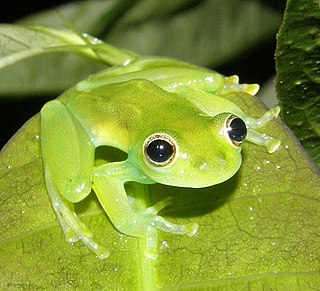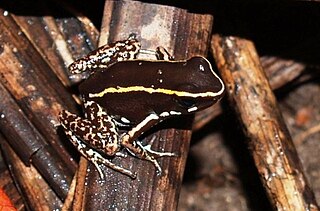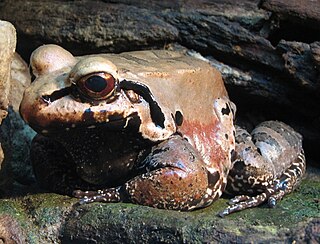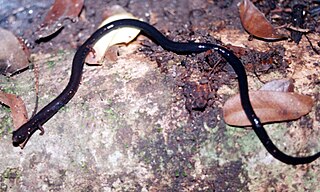Oedipina complex, commonly known as the Gamboa worm salamander, is a species of lungless salamander found in western South America from Costa Rica to western Colombia and north-western Ecuador. This species inhabits humid tropical lowland forest where it can be found on the ground, and on bushy vegetation, logs and rocks. It can also be found on forest edges, but it does not survive in degraded areas. Deforestation is a threat to this species.

Teratohyla spinosa is a species of frog in the family Centrolenidae. It is found in the Pacific lowlands of northern and central Ecuador and western Colombia, northward on the Pacific slopes Panama and Costa Rica, as well as on the Caribbean slopes of Costa Rica, Nicaragua, and Honduras.

Anomaloglossus wothuja is a species of frog in the family Aromobatidae. It is endemic to Venezuela and is only known from its type locality, the base of Cerro Sipapo, in the Amazonas state. It appears to be endemic to the Cerro Cuao massif but might occur more widely in similar granitic areas.

The lovely poison frog or lovely poison-arrow frog is a species of frog in the family Dendrobatidae. It is found on the Caribbean versant of Central America from southeastern Nicaragua through Costa Rica to northwestern Panama, with one record just west of the Panama Canal. Populations from the Pacific versant, formerly included in this species, are now identified as Phyllobates vittatus.

Isthmohyla tica, also known as Starrett's treefrog, is a species of frog in the family Hylidae. It is found in the Cordillera de Tilarán, Cordillera Central, and Cordillera de Talamanca of Costa Rica and western Panama. The specific name tica is derived from the name that Costa Ricans use to refer themselves, tico.
Callimedusa duellmani is a species of frog in the subfamily Phyllomedusinae. It is endemic to Peru and is only known from its type locality near Balzapata, upper Chiriaco River, in the Department of Amazonas. The specific name duellmani honors William E. Duellman, an American herpetologist. Common name purple and orange leaf frog has been proposed for it.

Scinax boulengeri is a species of frog in the family Hylidae. It is found in Colombia, Costa Rica, Nicaragua, Panama, and possibly Honduras. Its natural habitats are subtropical or tropical moist lowland forests, intermittent freshwater marshes, pastureland, plantations, rural gardens, and urban areas. It has been found as high as 600 meters above sea level.

Hyperolius nasutus is a species of frog in the family Hyperoliidae. Common names include long-nosed reed frog, sharp-nosed reed frog and long reed frog. It is known from northern Angola and northern Botswana, but it presumably occurs more widely. The nominal Hyperolius nasutus was partitioned in 2013 into three cryptic species, the other two being Hyperolius viridis and Hyperolius microps. All these species are members of the so-called Hyperolius nasutus species group, the "long reed frogs".

Craugastor fitzingeri is a species of frog in the family Craugastoridae. It is found in northwestern Colombia, Panama, Costa Rica, eastern Nicaragua, and northeastern Honduras. The specific name fitzingeri honors Leopold Fitzinger, an Austrian zoologist. Common name Fitzinger's robber frog has been coined for this species.
Craugastor fleischmanni is a species of frog in the family Craugastoridae. It is endemic to Costa Rica where it has been found on the Meseta Central Oriental and Occidental, the Pacific slopes of the Barva and Poás Volcanos, the Atlantic slopes of the Irazú and Turrialba Volcanos, and on the Cordillera de Talamanca. Common name Fleischmann's robber frog has been suggested for this species.
Diasporus tigrillo is a species of frog in the family Eleutherodactylidae. It is endemic to the valley of the Rio Larí in Limón Province, Costa Rica.

The smoky jungle frog is a species of frog in the family Leptodactylidae. It is found in Bolivia, Brazil, Colombia, Ecuador, Costa Rica, Panama, French Guiana, and Peru. Its natural habitats are tropical and subtropical moist broadleaf forests, subtropical or tropical swamps, subtropical or tropical moist montane forest, rivers, freshwater marshes, intermittent freshwater marshes, and aquaculture ponds.
Ctenophryne aterrima is a species of frog in the family Microhylidae. It is found in northwestern Ecuador, the Andes of Colombia, and lowland and premontane zones of Panama and Costa Rica to about 1,600 m (5,200 ft) above sea level.
Bradytriton is a monotypic genus of salamanders in the family Plethodontidae. it is represented by the species Bradytriton silus, commonly known as the Finca Chiblac salamander, and has been considered the sister taxon of the genus Oedipina. It is found in north-western Guatemala and in Chiapas, south-eastern Mexico.
Oedipina alfaroi is a species of salamander in the family Plethodontidae. It is found in the Caribbean versant of eastern Costa Rica and northwestern Panama. It is commonly known as the Limon worm salamander.

Oedipina cyclocauda, commonly known as the Costa Rica worm salamander, is a species of salamander in the family Plethodontidae. It is found on the Caribbean slopes of northwestern Panama, eastern Costa Rica, Nicaragua, and northern Honduras. The specific name cyclocauda refers to the circular caudal grooves.
Oedipina maritima, commonly known as the maritime worm salamander, is a species of salamander in the family Plethodontidae. It is endemic to Isla Escudo de Veraguas, Panama.

Oedipina taylori, commonly known as Taylor's worm salamander, is a species of salamander in the family Plethodontidae. It is found on the Pacific versant in south-eastern Guatemala, to central to north-eastern El Salvador and adjacent southern Honduras. Honduran populations might represent another species.
Ptychadena perreti is a species of frog in the family Ptychadenidae. It is found in Cameroon, Gabon, Republic of the Congo, southwestern Central African Republic and northern Democratic Republic of the Congo. It might occur in the Cabinda enclave of Angola and mainland Equatorial Guinea. Common name Perret's grassland frog has been coined for it.
Papurana supragrisea is a species of true frog, family Ranidae. It is endemic to New Guinea, including some nearby islands. It is known with certainty only from southeastern New Guinea and from the D'Entrecasteaux Islands. However, this name has been used more broadly for a species complex that is widely distributed in the mountains of New Guinea. Common name Papua gray frog has been coined for it.










